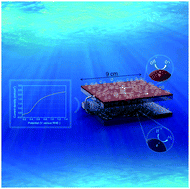Large area high-performance bismuth vanadate photoanode for efficient solar water splitting†
Abstract
Commercial-scale photoelectrochemical (PEC) water splitting devices have been proved to be cost-competitive with fossil-based fuels. Nevertheless, large-scale PEC water splitting cells with high performance have not yet been demonstrated, and controllably scaling up high-performance photoelectrodes still remains challenging. Typically, bismuth vanadate (BiVO4) has been regarded as one of the most efficient photoanodes for use in PEC water splitting because of its well-suited band structure. However, state-of-the-art PEC performances achieved with BiVO4 photoanodes to date have generally been tested on small scales (<1 cm2), due to the nonuniformity of the scaled-up photoactive films, increased resistive losses and inhomogeneous potential distribution in scaled-up substrates, non-linear diffusion of reactants and resultants toward scaled-up photoanodes and so on. Here, a uniform scaled-up precursor (BiOI) film was prepared via a spatial-current-density-distribution-regulated electrodeposition method with a tilt-electrode-configuration. The as-prepared BiOI film was covered with a thin vanadium source layer and then converted to BiVO4 film via a modified thermal-chemical conversion method. The photocurrent density for sulfite oxidation of the 54.32 cm2 BiVO4 photoanode (∼2.55 mA cm−2 at 1.23 VRHE) was the highest value yet reported, and it was comparable with that of the 1.66 cm2 BiVO4 photoanode (∼2.85 mA cm−2 at 1.23 VRHE). To reduce resistive losses and improve the homogeneity of distributed potential in the FTO substrate, metal grids were deposited on the BiVO4 photoanode via thermal evaporation. The maximum fill factor of the photocurrent density curve of the scaled-up BiVO4 photoanode was raised from ∼29 to ∼44.5%. After the uniform coating of an oxygen evolution catalyst (OEC) layer that was formed by connecting tannin acid molecules with metal ions, the photoanode achieved a photocurrent density of ∼2.23 mA cm−2 at 1.23 VRHE and ∼0.83% STH conversion efficiency at 0.65 VRHE. Finally, the stability test was conducted in a designed test system with water circulation to facilitate diffusion of generated oxygen. The scaled-up OEC/BiVO4 photoanode showed <4% decay after operating under harsh conditions for 5 h.



 Please wait while we load your content...
Please wait while we load your content...